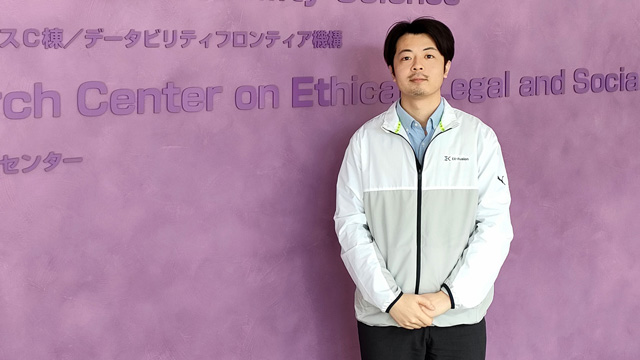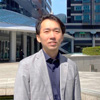JETRO Global Connection -Accelerate Innovation with Japan-
Interview
Extending the Possibilities of Laser Fusion
(Japan)
May 31, 2023

Could you introduce yourself and the company?
I am the CEO of EX-Fusion![]() , and my name is Kazuki Matsuo
, and my name is Kazuki Matsuo![]() . I completed my Ph.D. at the Institute of Laser Engineering at Osaka University (ILE)
. I completed my Ph.D. at the Institute of Laser Engineering at Osaka University (ILE)![]() , one of this field's oldest and most famous research facilities. In 2021, I was a postdoctoral fellow at the University of California, San Diego. After that, I founded the company with my supervisor, Shinsuke Fujioka, a professor of ILE, along with Yoshitaka Mori, an Associate Professor at The Graduate School for the Creation of New Photonics Industries
, one of this field's oldest and most famous research facilities. In 2021, I was a postdoctoral fellow at the University of California, San Diego. After that, I founded the company with my supervisor, Shinsuke Fujioka, a professor of ILE, along with Yoshitaka Mori, an Associate Professor at The Graduate School for the Creation of New Photonics Industries![]() (GPI).
(GPI).

Kazuki Matsuo, EX-Fusion Inc. CEO (Photo by JETRO)
ILE and GPI are two universities in Japan focused on laser fusion research. This company is focused on the optimization of laser fusion reactors. Now we are trying to develop laser control equipment for a laser fusion reactor. We have made proof-of-concept of the components, but the challenge is integration because there are many components. The next step is to make sure that the system is working.
EX in the name EX-Fusion has multiple meanings. Our primary purpose is to extract fusion energy. So it means extracting fusion energy and also exploring future laser applications. There are a lot of applications like laser processing or lightning. Another meaning is to extend the possibilities of fusion.
What challenges are you trying to solve?
Our challenge is the implementation and commercialization of laser fusion. A US academic study published in December 2022 strongly supported the commercialization of laser fusion reactor technology, but implementation challenges exist before commercializing it. The two issues are efficiency and continuous performance. To commercialize, we need at least 50 times the gain, so we need to increase the efficiency of the fusion reaction generation. Achieving continuous operation of laser fusion reactions is another issue. We must wait eight hours for the next shot when we shoot the laser.
To improve this, we focus on the fast ignition method, initially developed by Osaka University. The research results demonstrated ten times higher energy transfer efficiency than the conventional results. For a high-repetition laser, we developed a new laser system and control system, which is now the focus of this startup.
In the past, R&D for laser fusion was usually sponsored by governments of countries like Japan or the US. However, the pace of research was slow because it was funded by taxpayers and subject to annual government budgets. EX-Fusion will use proprietary technology, startup partnerships, and a higher risk tolerance to commercialize laser fusion.

Laser Plasma Experiments in EX-Fusion Inc. (Provided by EX-Fusion)
What challenges have you faced as a startup?
I was a researcher two years ago and didn't know much about startups. It was difficult to understand how to start a company and how to manage it, but the most difficult is getting research money from other institutes. Fusion needs a lot of money to keep the research going.
Who is your target customer?
The customer base is very broad because fusion is not only for laser fusion. We have already made a contract with the Australian Government, which wants to build a high-power laser system, but they do not have the technology in place yet. First of all, they want to use it for heavy ion radiography because lasers can accelerate the heavy ion radiography used in cancer treatment.
Do you have any global competitors?
There are several laser fusion startups. For example, in the US, Focused Energy is one of the startups that want to build a laser fusion reactor. But it's not a direct competitor because we have our base, the laser system. Our position is unique because we have a middle layer of the business model and can provide a laser system to companies building a laser fusion reactor.
What's the difference between what you do and competitors like Marvel Fusion?
The fusion method that they use is different. Marvel does beam fusion, which is a very high intensity laser injecting the target first. That starts to make the proton beam and the proton beam injects the boron, making the fusion reaction generation. In their case, the laser acts to accelerate the proton. In our case, we do inertial confinement fusion (ICF), in which the laser is used for the compression of the target, not acceleration of the proton. The type of fusion is different and the laser is different. They need a very high-intensity laser, but our method compresses the target and we need a longer-power laser.
Are you collaborating with any Japanese companies?
Yes, we are working with JTEC, which is an Osaka company making a very special kind of radar. Originally, they made radar for an X-ray system, but they also can provide the media for laser systems so we can collaborate with them.
Have you worked with JETRO before?
Yes, JETRO introduced us to the Berkeley Skydeck program to expand our business abroad. They're very helpful for us because, as a researcher, I don't know about the process of exporting. In the near future, when we want to export something, like laser components, we will ask for their advice on international markets and local laws.
What is your current IP strategy? Do you have IP in several countries?
We have three patents related to laser fusion reactors and laser fusion systems, but it's not enough to protect our technology by itself. That's why we are trying to expand the IP of our laser system. One unique thing about our company is that we do not focus on the components. We focus on the system's IP because we think that it's harder to copy than separate components. We buy or collaborate with other companies and integrate them into one system.
One of our IPs is related to the timing-controlling system. We have this IP already for the US, Japan, EU, Korea, and India. For other IPs, we will also look at multiple countries, not just Japan. JETRO has many offices around the world dealing with IP, and if they can support this strategy, it's beneficial to us.
What is your message to partners, investors, etc.?
We want to find some venture capitalists who are interested in our business, not only the Japanese investors but also the VCs from overseas like the US.
Laser technology is very complex and unique, so it is a little bit difficult to gather the technology in one company. The US laser fusion is related to the defense problem, so the startups cannot use the asset of the technology from the national regulation or facility, but in Japan, it is easy to collaborate. For example, we were born at Osaka University that has the technology of the laser or laser system itself. Our position is very unique compared to the other startups, so some of the VCs from the US are interested in us, but not enough. We try to get more and more attention from them.
- Profile of Kazuki Matsuo,CEO,EX-Fusion Inc.
- The CEO of EX-Fusion and founded it in 2021. His background is in Applied Physics, with diverse experiences in researching Inertial Confinement Fusion (ICF) for energy production, high energy density plasma physics, and developing X-ray diagnostics.
- Report by:
- YAMAZAKI Yusuke, Startup Support Division, JETRO

- Report by:
- KAGA Yusuke, Startup Support Division, JETRO

-
Overview of Japanese Startup Investment for US Venture Capitalists

May 2025
-
TBM, a Japanese Unicorn, is taking its environmentally conscious materials and solutions global

April 2025
-
Algal Bio’s Plan to Scale-up Microalgae Solutions for Food, Health, Climate, and more

March 2025
-
From Complexity to Clarity: How Veritus Helps Professors and Research Labs Innovate 5X Faster

February 2025
-
Biodata bank: Innovating Heat Risk Solutions for a Warming World

February 2025
-
Thermalytica’s Improved, Nano-scale Insulation Technology Could Change the World

January 2025
-
Techstars Tokyo Demo Day shows how Japan is Making Strides Towards Becoming a Global Startup Hub

December 2024
-
Redefining Health Through Better Movement with Shosabi

December 2024



